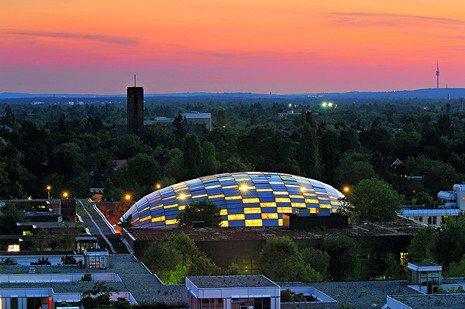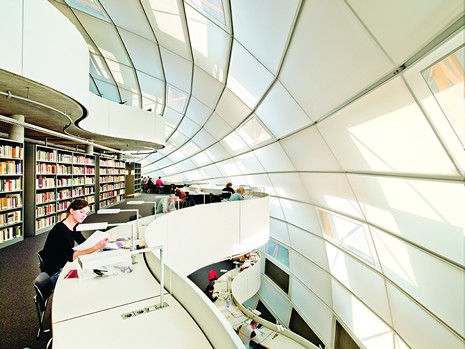Description
The Freie Universität or Free University, whose name references its placement in then West Berlin, was founded in 1948 as an alternative to the Humboldt Universität in the Russian sector of the postwar city. Originally housed in various villas in the suburb of Dahlem, in 1973, the campus complex was completed as a group of buildings designed from a 1963 prize-winning competition entry by the partnership of Candilis, Josic, Woods. The design is a manifesto of Team X’s ideological departure from CIAM and reflected their humanistic ideology that “in everyday usage … the inextricable complexity of urban life is expressed. (
As part of the redevelopment of the campus 34 years later, Norman Foster received the commission to refurbish the Candilic, Josic, Woods complex and to design a new library for the Faculty of Philology and Humanities. Sited within a space previously occupied by six courtyards of the complex, Foster’s new library integrates ten separate, departmental libraries. The five-story, glass and concrete ovoid structure occupies the majority of the newly created courtyard. It connects to the existing complex at the two extreme ends of the oval form on its principal axis of rotation. These connections replace the many purposefully indirect and meandering paths that were the hallmark of the original design. Four serpentine floor plates, one above the other and receding in size, are centered on this axis in an open structure. On each floor, books are located at the center while users are allocated space on the perimeter at continuous, curvilinear built-in reading desks and guardrails. Accommodating more than 600 users in adjacent, unidirectional seats, the design promotes quiet study and research.
A curved, double-layered dome of glazed and aluminum exterior panels contains the concrete internal structure. The inner layer, a membrane of glass fiber, is attached to the external glass skin through a yellow-painted, wide-span steel structure. Operable apertures in both membranes allow for the circulation of fresh air and, ultimately, provide natural ventilation for more than 50 % of the year. The inner layer also serves to filter the daylight entering through the external glazing, providing readers with a diffused, natural light. At the time of completion, the library was noted as one of Foster’s greatest efforts toward sustainability and reflected the firm’s commitment to research in the use of active and passive technologies.
The library’s cranial-like floor plan and volume have earned it the nickname of “Berlin Brain”. While valve-like entrances and other physiological analogies make this comparison plausible, the library as a variation on the curved, monumental structure is part of a Foster evolution that includes the American Air Museum, the Great Glass House, Canary Wharf Underground Station, the Reichstag and the London City Hall. Utilizing the analogy of the brain as the center of the human nervous system, the new Philological Library similarly assumes a central importance within the Candilis, Josic, Woods complex – an importance that refutes the principles of its Modernist host. The judgment to use this project as a vehicle for the exploration of form within a site imbued with such historical and theoretical significance is perhaps an indication of progress and its costs – the subject of Le Corbusier’s letter to the final CIAM congress before its succession by Team X.
Drawings
Ground floor
Third floor
Roof view
Elevation of institute building and section through library
Cutaway axonometric view of the library
Photos

Night view of the library on campus

Study counters receive optimum daylight from the dome
Originally published in: Nolan Lushington, Wolfgang Rudorf, Liliane Wong, Libraries: A Design Manual, Birkhäuser, 2016.